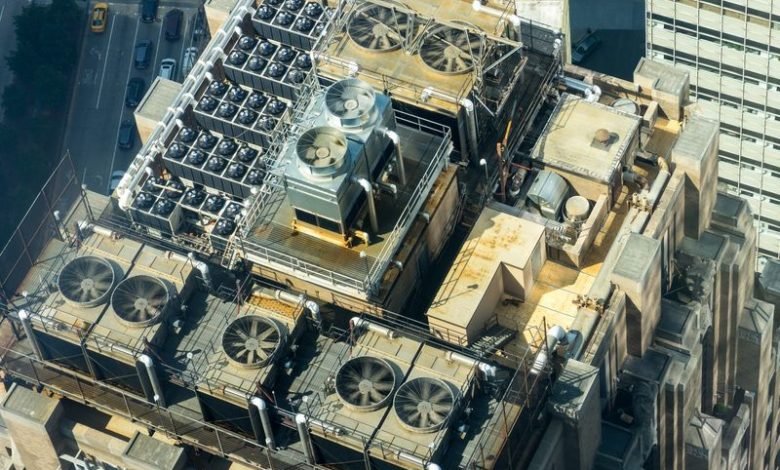Why Do We Use Louvers in the Cooling Towers?

A device that will regulate airflow and also light penetration, yes, I am talking about louvers. Your house might have a louver or two but did you know that louvers are also installed at industrial cooling towers? Thus, in this article, we will explore the role of cooling tower air inlet louvers. A louver is a type of window blind or shutter that has horizontal slats that are tilted to let light and air in while keeping rain and direct sunlight out. The angle of the slats can be adjusted or set, like in blinds and windows.
Purpose of louvers in Cooling tower
The major purpose of the air intake louvers for cooling towers is to provide a barrier against sunlight, noise, water splash-out, and debris while also increasing the cooling tower’s airflow and beauty by blocking air movement.
What are air inlet louvers?
The sun’s light is blocked from entering the cooling tower basin by the air Inlet Louvers. The installation of air inlet louvers aids in the management of algae development.
Cooling tower maintenance
Scaling can reduce the cooling tower’s airflow efficiency and performance as it becomes older, especially if the air intake louvers for cooling towers aren’t properly maintained. Sunlight is also kept out of the cooling tower by air intake louvers. It’s vital to keep sunlight out of the basin to avoid algae formation.
Scaling- an issue you must be aware of
Scaling is a common issue at industrial cooling towers that make the louvers less accessible and much more difficult as they become older, especially if the air intake louvers are not properly maintained. By blocking air movement, scaled louvers might reduce your efficiency. You may choose from a variety of coatings and materials that we manufacture, sell direct, and install to meet the specific demands of your location, industry, and needs. scaled louvers might reduce your efficiency.
Lowering chemical expenses requires controlling the light and reducing algae development. The quantity of splash-out from the cooling tower is also reduced by using air Inlet louvers. This cuts down on the quantity of water and chemicals required to keep the cooling tower running well.
Types of louvers
Louvers are a form of damper that consists of many parallel blades positioned over a duct. They are adaptable, lightweight, small, and have minimal leakage to the outside world.
- Combination louvers: They feature blades that open partially at one static pressure level and entirely at another. And are made entirely of aluminum to withstand corrosion.
- Stationary Louvers: Weather protection and sound attenuation may be provided by stationary louvers with angled or airfoil-style blades.
- Measuring air: The vertical blades of air measurement louvers are tightly separated to avoid water infiltration.
- Adjustable Louvers: Airfoil-bladed adjustable louvers are also widely available
Characteristics of louvers in cooling towers
Cooling towers louvers come in a variety of shapes and sizes. An air intake louver cooling tower or a louver cellular panel are also options. Each is likewise unique in terms of design and materials.
- It blocks sunlight from entering the basin of the tower. Algae and even certain bacterial species may develop when they are exposed to sunshine.
- It prevents water from splashing out, allowing water to remain in the collection tank.
- It aids in the prevention of big objects or debris entering the tower.
- Making a proper temperature cooling is difficult to restrict from the water pipe to the spray nozzle.
- It cuts maintenance expenditures, such as algae-killing chemicals, to the bare minimum.
Basic noticeable features in louvers for cooling towers
- Adaptability: The cooling towers’ intake louver is made to accommodate a variety of structures. A cooling towers louver can be installed on a freshly constructed tower as well. It may also be adapted to existing towers, avoiding the need for major alterations.
- Practical design: The purpose of the cooling tower louver design isn’t just to make the cooling tower look nice. The louver is designed to act as a barrier against sunlight, big debris, and to promote ventilation within the tower. It’s useful for ensuring an algae-free tower, water splash-out avoidance, and the tower’s general functionality.
- The surface is smooth: Scale build-up is one of the issues with cooling tower louver cleaning and maintenance. To avoid this, cooling tower louvers have a smooth and glossy surface that aids in scaling prevention. As a result, it can help you save money and time on maintenance.
- Resistance to Corrosion: This function can also extend the life of cooling tower louvers, making them a more cost-effective product for you.
Conclusion
Louvers are highly beneficial in cooling towers and have an array of advantages for smooth functioning in the long run. To know more, connect with the best IGGTGlobal today.
If you enjoyed reading this post, do visit this page for more informative articles.






